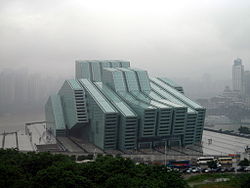| Chongqing Grand Theatre | |
|---|---|
重庆大剧院 | |
 Chongqing Grand Theatre at night | |
 | |
| Alternative names | Chongqing Opera House |
| General information | |
| Status | Completed |
| Location | Confluence of the Yangtze and Jialing Rivers, Jiangbei, Chongqing, China |
| Coordinates | 29°34′07″N106°34′49″E / 29.568623°N 106.580384°E |
| Construction started | 2005 |
| Completed | 2009 |
| Cost | 1.595 billion yuan |
| Height | 64 metres (210 ft) |
| Dimensions | |
| Diameter | 220 metres (720 ft) |
| Technical details | |
| Floor count | 7 |
| Floor area | 103,307 square metres (1,111,990 sq ft) |
| Design and construction | |
| Architecture firm | Gmp Architekten |
The Chongqing Grand Theatre (or Theater) is a performing arts venue in central Chongqing, People's Republic of China, located overlooking the Yangtze River. [1] The 64-metre six-storey building was constructed from 2005 until 2009. Hassell, a design company, took part in a competition to decide how the building was constructed and laid out. [2] The building contains two concert halls.[ citation needed ]
